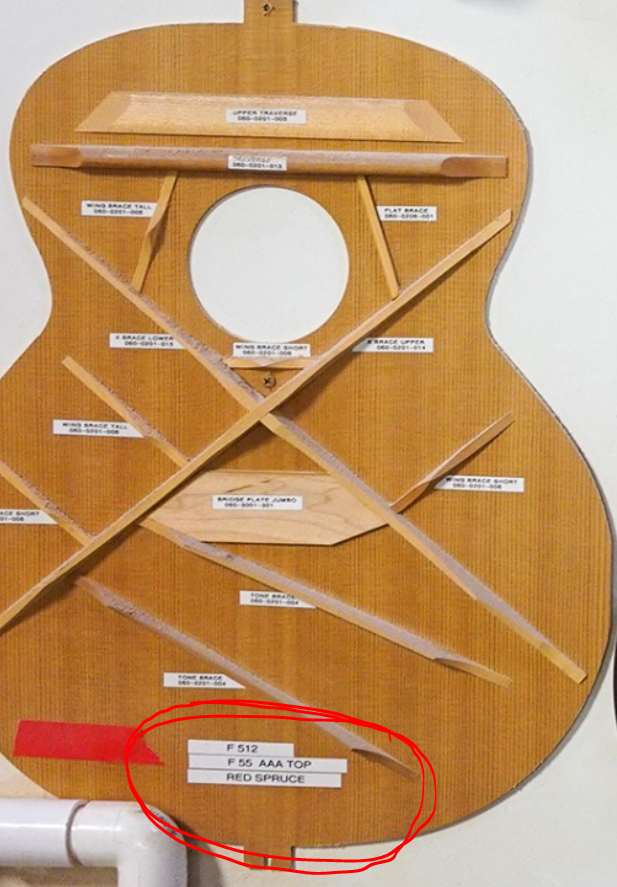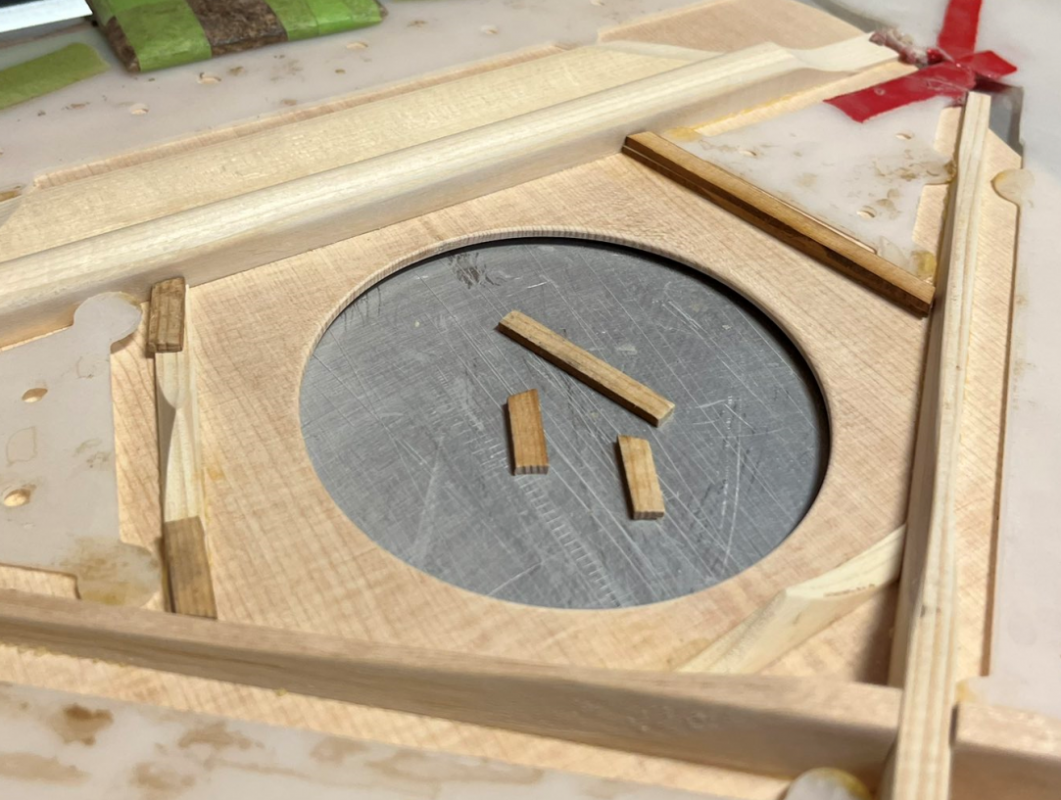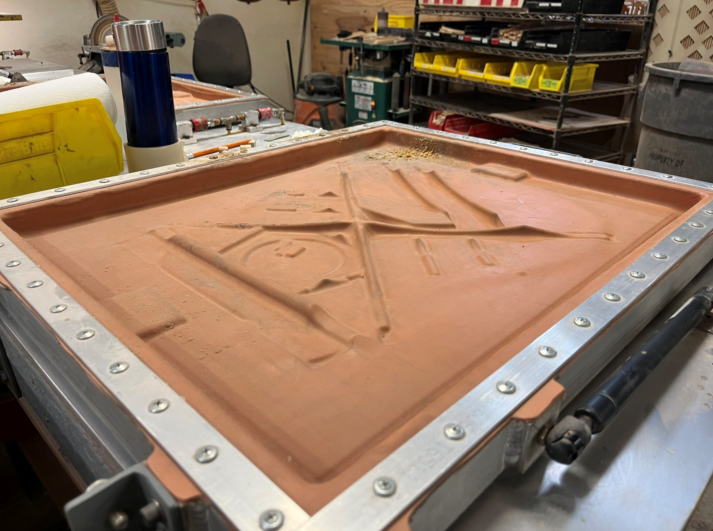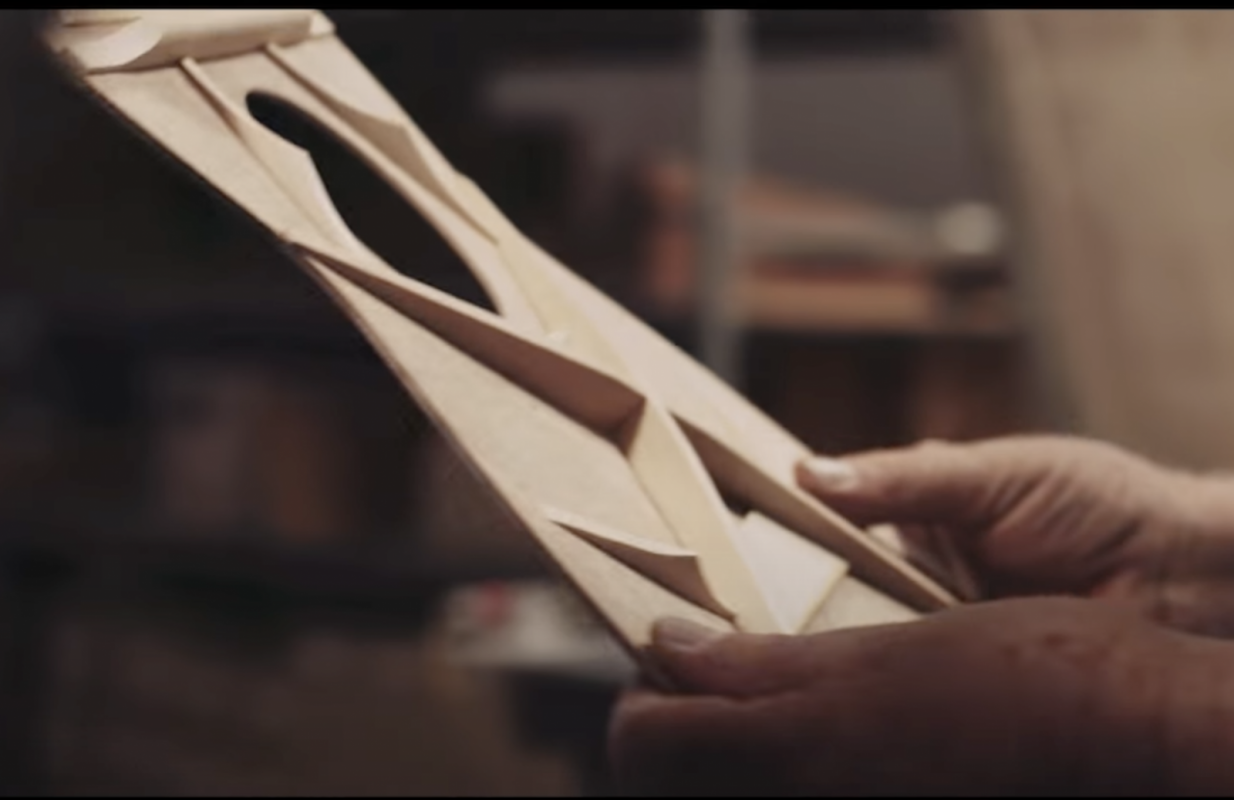I saw that, Ralf, but I wasn't clear that the description you put there meant they were sharing the same soundboard bracing. Are they?Study all the pictures I posted!
You are using an out of date browser. It may not display this or other websites correctly.
You should upgrade or use an alternative browser.
You should upgrade or use an alternative browser.
New bracing techniques in Oxnard
- Thread starter Yura
- Start date
GGJaguar
Reverential Member
Maybe it coincided with the change to red spruce braces.I really want to know when the F-512 started getting built with two belly braces rather than three.
SFIV1967
Venerated Member
SFIV1967
Venerated Member
Thank you all, guys, very, very interesting indeed !! Special thanks for @SFIV1967 for all the pics ( if not too much to ask - will it be possible to get full pic including belly braces for D-55 and M-20 ? Or is it safe to assume that at least D-55 has the same bracing as D-20 with flat brace on bass side ?) Thanks in advance.
SFIV1967
Venerated Member
Fantastic !! thanks a lot @SFIV1967 !
Rayk
Enlightened Member
- Joined
- Apr 19, 2015
- Messages
- 5,788
- Reaction score
- 1,191
I maybe wrong but I’m not sure how much bracing around the sound hole effects tone ? I figure it’s just more decorative . Force field ingaged ! lol  !
!
I’ll have to re read the post but said bracing couldn’t be the same each model but looking at Ralf’s pics it looks like it . I find that , I don’t know how I find it ? lol seems wrong each model should have it’s own distinctive shaping the Orphs were as mentioned, my past OM was very controlled in its tone can’t say I got the age old feeling from it though. Oh look it’s raining !
I’ll have to re read the post but said bracing couldn’t be the same each model but looking at Ralf’s pics it looks like it . I find that , I don’t know how I find it ? lol seems wrong each model should have it’s own distinctive shaping the Orphs were as mentioned, my past OM was very controlled in its tone can’t say I got the age old feeling from it though. Oh look it’s raining !
Boneman
Senior Member
- Joined
- Aug 22, 2021
- Messages
- 1,392
- Reaction score
- 1,668
- Guild Total
- 6
That would be a cool poster for the shop!
Not decorative, Ray, although there are folks like us who appreciate braces in their own right... Almost always it's for strength since a soundboard without braces would not stay in one piece or even maintain its basic shape for long without them. But, the secondary issue, and the important one to us here, is what it does to the voice of the guitar.I maybe wrong but I’m not sure how much bracing around the sound hole effects tone ? I figure it’s just more decorative . Force field ingaged ! lol!
I’ll have to re read the post but said bracing couldn’t be the same each model but looking at Ralf’s pics it looks like it . I find that , I don’t know how I find it ? lol seems wrong each model should have it’s own distinctive shaping the Orphs were as mentioned, my past OM was very controlled in its tone can’t say I got the age old feeling from it though. Oh look it’s raining !
As for every model having it's own braces.... Well, I don't think you'll find that to be true. That's why our research here is important. Well, to me anyway.
Rayk
Enlightened Member
- Joined
- Apr 19, 2015
- Messages
- 5,788
- Reaction score
- 1,191
No the braces don’t seem to be different, think I said that after seeing the pics ? I never gave much thought to a model line so much as to one particular guitar .Not decorative, Ray, although there are folks like us who appreciate braces in their own right... Almost always it's for strength since a soundboard without braces would not stay in one piece or even maintain its basic shape for long without them. But, the secondary issue, and the important one to us here, is what it does to the voice of the guitar.
As for every model having its own braces.... Well, I don't think you'll find that to be true. That's why our research here is important. Well, to me anyway.
My head says each model should have its own tonal distinction and now I’m confused a bit because why would a D50 sound any different then the D55 or any other like model less the tone woods of course if they primarily share the same specs ?
I was thinking after seeing the bracing pictures that maybe the difference would be in the tuning of the braces but though hard to tell the braces look identical in all photos so IDK . lol
As to the braces around the sound hole from things I’ve read though not covering the said braces that the sound hole area is kind of a dead zone . I get that in part from the age old argument over whether or not adding a pick guard changes the tone of the guitar ? Also vibration wise there’s not a whole heck of lot of area for wood to vibrate, you have the neck block ( giant brick ) lol a bar brace going across just in front of that then there’s a thin support ring glued around the sound hole then there’s fancy little pyramid braces around the whole thing plus the giant X brace.
It’s kind’a like Fort Knox in there or the gateway to Cheyenne mountains military base.
So yeah I guess I need to poke some bears AKA luthiers about its functionality . lol
I think we're in violent agreement, Ray.No the braces don’t seem to be different, think I said that after seeing the pics ?
By all means, poke the bears, Ray!So yeah I guess I need to poke some bears AKA luthiers about its functionality . lol
When I was a cadet at the Air Force Academy in 1980, I was hoping to get a tour of Cheyenne but never did. Cheyenne Mountain was the HQ for Strategic Air Command (SAC) Missile Command in those days, and I would've loved to have seen it. There were rumors among the cadets that there were tunnels between the academy and the mountain. I never got up the courage to go look. The door at the entrance in the tunnel was supposed to be some piece of work, but even more crazy is that the entire base was supposed to be suspended on giant springs deep within the mountain. I have no idea if that was true, but it's certainly within the realm of possibility. As late as 1980, I don't know if Cheyenne could've survived a nuke, but I'm glad we never found out!It’s kind’a like Fort Knox in there or the gateway to Cheyenne mountains military base.have you seen that Door !?
GardMan
Enlightened Member
OK... At the risk of taking some heat, I am going to argue that, at least in the dreadnaught models, Guild Oxnard hasn't introduced any GRAND departure in the top bracing pattern that they have used for years. As exhibit 1, here is a cropped version of the "new" bracing of a dreadnaught top posted by Ralf (Thanks for the pic, Ralf! How did you find the images you posted?):
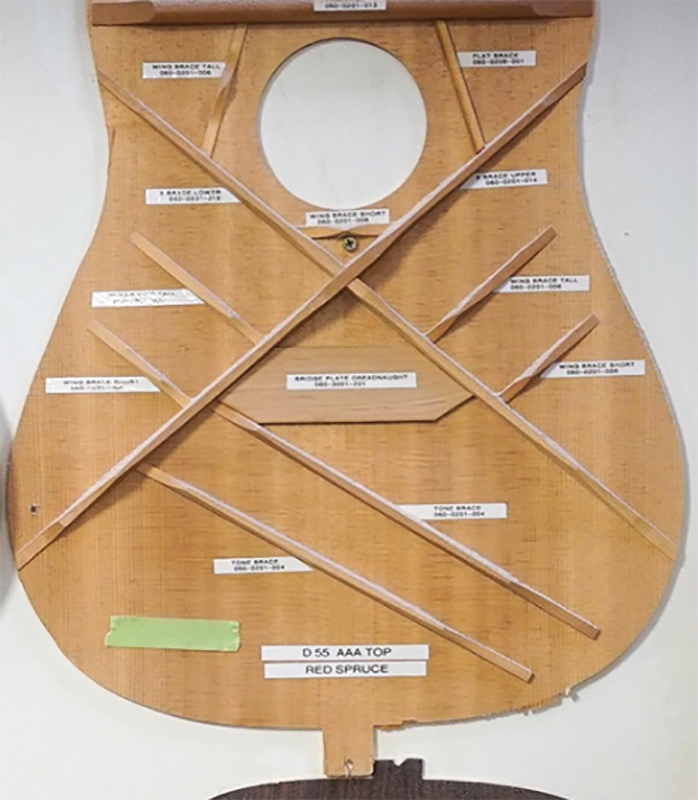
For exhibit 2, here is a "Henkogram" showing the bracing of my 1972 Guild D-35, taken from my bracing blog, but flipped around so that it is in the same orientation as Ralf's image):
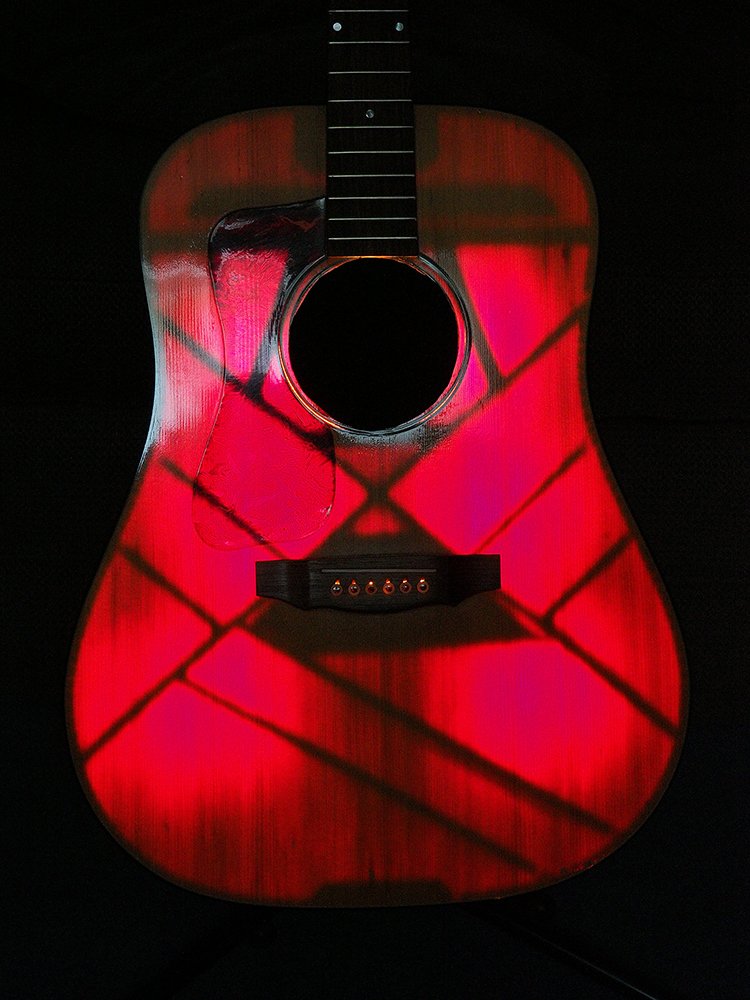
To my eye, every brace in the "new" bracing has a counterpart in the 1972 bracing, and the braces are in roughly the same position.(I didn't measure or try to superimpose them).
Now, there are some notable differences:
First, overall, the Oxnard braces appear to my eye to be noticeably thinner than what I am used to seeing in my Westerly-built instruments. I haven't really followed the specs of the new Guilds, but know that some models are using red spruce for braces, which, being stiffer, would allow the braces to be thinner (thus less mass).
Next, the braces surrounding the sound hole, those flanking it and below the soundhole (between the sound hole and the X brace intersection), have a new, taller profile. In the Westerly models/years in which these braces were used (the was a period when the sound hole of at least some dread models was reinforced by a single plate), they were short/shallow and wide... sort of the profile of a tongue depressor (wide enough that, for a period of time in the 70s and 80s, Guild stamped the top completion date on them). In the Oxnard pattern, the braces surrounding the sound hole look taller and thinner, and the brace on the treble side and below the sound hole are heavily scalloped.
It also appears to me that the Oxnard braces are substantially more "scalloped" overall compared to what I have seen in my sampling of Westerly-era Guilds ('82 D-70, '92 D-55, two '94 DV-72s, and a '95 DV-73)... again, this might be a consequence of using red spruce for bracing: red spruce being would allow more of the brace to be removed by scalloping, without compromising function (but perhaps altering tonal charcteristics)
Finally, the Oxnard bridge plate appears substantially smaller than that in the '72 D-35 example I am showing... but my later Westerly dreads also had smaller (maple) bridge plates.
One final comment... tho' the neck block region of the dread tops isn't shown in the pics Ralf posted, from the F-55 and M-20 pics, it appears that Guild Oxnard is going back to a "popsicle"-like brace in this region of the top (called the "upper transverse brace" in the F-55 pic Ralf posted)... similar to what was found in Westerly models prior to sometime in 1974. After mid-74, the "popsicle brace" was replaced by an extension of the neck block and a pair of thin "wing" braces between the first transverse brace and the shoulders:
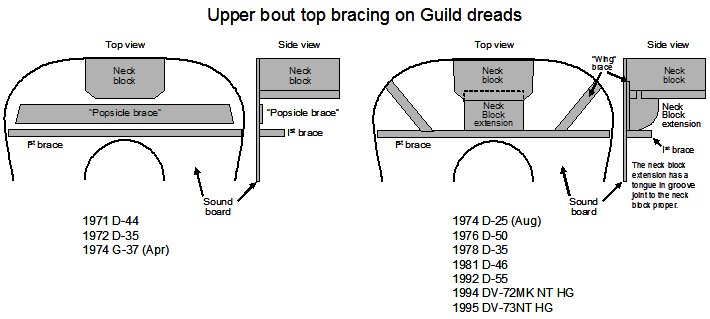
The Oxnard "Upper transverse brace" appears to have a rounded profile from what I can see, in contrast to the simple, flat stick I see in my '72 D-35. Can anyone with a Oxnard-made dread confirm that the neck block extension is gone?
So, after looking at the pics and thinking about them as this thread progressed, MY conclusion is that Guild Oxnard (Ren?) was continuing a progression that Guild began with the DV series built in Westerly, beginning in 1993, returning to traditional bracing patterns (with some refinements in materials and shapes) from Guild's early days. That's just my take on the matter... as always, YMMV.

For exhibit 2, here is a "Henkogram" showing the bracing of my 1972 Guild D-35, taken from my bracing blog, but flipped around so that it is in the same orientation as Ralf's image):

To my eye, every brace in the "new" bracing has a counterpart in the 1972 bracing, and the braces are in roughly the same position.(I didn't measure or try to superimpose them).
Now, there are some notable differences:
First, overall, the Oxnard braces appear to my eye to be noticeably thinner than what I am used to seeing in my Westerly-built instruments. I haven't really followed the specs of the new Guilds, but know that some models are using red spruce for braces, which, being stiffer, would allow the braces to be thinner (thus less mass).
Next, the braces surrounding the sound hole, those flanking it and below the soundhole (between the sound hole and the X brace intersection), have a new, taller profile. In the Westerly models/years in which these braces were used (the was a period when the sound hole of at least some dread models was reinforced by a single plate), they were short/shallow and wide... sort of the profile of a tongue depressor (wide enough that, for a period of time in the 70s and 80s, Guild stamped the top completion date on them). In the Oxnard pattern, the braces surrounding the sound hole look taller and thinner, and the brace on the treble side and below the sound hole are heavily scalloped.
It also appears to me that the Oxnard braces are substantially more "scalloped" overall compared to what I have seen in my sampling of Westerly-era Guilds ('82 D-70, '92 D-55, two '94 DV-72s, and a '95 DV-73)... again, this might be a consequence of using red spruce for bracing: red spruce being would allow more of the brace to be removed by scalloping, without compromising function (but perhaps altering tonal charcteristics)
Finally, the Oxnard bridge plate appears substantially smaller than that in the '72 D-35 example I am showing... but my later Westerly dreads also had smaller (maple) bridge plates.
One final comment... tho' the neck block region of the dread tops isn't shown in the pics Ralf posted, from the F-55 and M-20 pics, it appears that Guild Oxnard is going back to a "popsicle"-like brace in this region of the top (called the "upper transverse brace" in the F-55 pic Ralf posted)... similar to what was found in Westerly models prior to sometime in 1974. After mid-74, the "popsicle brace" was replaced by an extension of the neck block and a pair of thin "wing" braces between the first transverse brace and the shoulders:

The Oxnard "Upper transverse brace" appears to have a rounded profile from what I can see, in contrast to the simple, flat stick I see in my '72 D-35. Can anyone with a Oxnard-made dread confirm that the neck block extension is gone?
So, after looking at the pics and thinking about them as this thread progressed, MY conclusion is that Guild Oxnard (Ren?) was continuing a progression that Guild began with the DV series built in Westerly, beginning in 1993, returning to traditional bracing patterns (with some refinements in materials and shapes) from Guild's early days. That's just my take on the matter... as always, YMMV.
DAve, that's awesome. I was wondering when you were going to pop in...
I agree that mostly what's happened is a refinement in shaping of the various braces. When you have some time, I'd love to see an actual picture of the brace that started all this from your '72 D-35, namely the one that's currently a "wing" brace right in front of the bridge. But, anyway, great analysis and questions, Dave. I obviously don't have the answers.

I agree that mostly what's happened is a refinement in shaping of the various braces. When you have some time, I'd love to see an actual picture of the brace that started all this from your '72 D-35, namely the one that's currently a "wing" brace right in front of the bridge. But, anyway, great analysis and questions, Dave. I obviously don't have the answers.
Here is a brief, 30,000 ft overview:
Alterations in material species, moisture content, grain direction and pattern will affect overall sound.
Alterations in design and dimensions will affect overall sound.
Alterations in construction, technique, accuracy, consistency will affect overall sound.
The stiffness of the soundboard and the stiffness of the bracing will affect overall sound.
An acoustic guitar’s overall sound is the sum total of its parts, so everything plays a role. But, all other things being equal, if there was one element, one factor that, when altered, could have the most dramatic affect on the overall sound, what would it be?
Bracing.
Regardless of design, precise, identical dimensioning and precise, identical placement of bracing will yield the closest approximation to identical sounding models (all other things being equal).
*** Make the slightest change and you either must employ the marketing team to come up with a new model to justify the new sound, or you gain a reputation like some well-known brands did/have done/do, where models were/are “hit or miss."
Taylor, love ‘em or hate ‘em, builds guitars nearly completely by robotics, with CNC precision and repeatability. They get really close to identical overall results within model lines, batch after batch after batch.
For Guild (or Martin, or any company) to make guitars across many decades and be able to maintain a consistency in overall sound, or if that sound is altered, to manage the expectation of the consumer, is a staggering accomplishment to me!
The beachfront property, the prime real estate of the acoustic guitar, is the area of the soundboard from the bridge to the tailblock. That is where it all comes to matter. Tiny, tiny changes to soundboard material, thickness or stiffness, and/or bracing material, stiffness, dimensions and *placement* CAN dramatically alter the overall sound.
If any remain skeptical, consider this: If what I have explained above was not the case, you would only need one builder, as every guitar would sound alike.
Alterations in material species, moisture content, grain direction and pattern will affect overall sound.
Alterations in design and dimensions will affect overall sound.
Alterations in construction, technique, accuracy, consistency will affect overall sound.
The stiffness of the soundboard and the stiffness of the bracing will affect overall sound.
An acoustic guitar’s overall sound is the sum total of its parts, so everything plays a role. But, all other things being equal, if there was one element, one factor that, when altered, could have the most dramatic affect on the overall sound, what would it be?
Bracing.
Regardless of design, precise, identical dimensioning and precise, identical placement of bracing will yield the closest approximation to identical sounding models (all other things being equal).
*** Make the slightest change and you either must employ the marketing team to come up with a new model to justify the new sound, or you gain a reputation like some well-known brands did/have done/do, where models were/are “hit or miss."
Taylor, love ‘em or hate ‘em, builds guitars nearly completely by robotics, with CNC precision and repeatability. They get really close to identical overall results within model lines, batch after batch after batch.
For Guild (or Martin, or any company) to make guitars across many decades and be able to maintain a consistency in overall sound, or if that sound is altered, to manage the expectation of the consumer, is a staggering accomplishment to me!
The beachfront property, the prime real estate of the acoustic guitar, is the area of the soundboard from the bridge to the tailblock. That is where it all comes to matter. Tiny, tiny changes to soundboard material, thickness or stiffness, and/or bracing material, stiffness, dimensions and *placement* CAN dramatically alter the overall sound.
If any remain skeptical, consider this: If what I have explained above was not the case, you would only need one builder, as every guitar would sound alike.
Absolutely, positively!An acoustic guitar’s overall sound is the sum total of its parts, so everything plays a role. But, all other things being equal, if there was one element, one factor that, when altered, could have the most dramatic affect on the overall sound, what would it be?
Bracing.
AcornHouse
Venerated Member
As regards the soundhole bracing; that big hole adds a huge weak point in the soundboard. Traditionally it was braced with fairly low, flat, bits of wood, often quite wide, as in the classical model.
Having the X-braces closer to the soundhole helps but experiments by Somogyi, and others, have shown that the height of braces is more important to their strength than a comparable width. So having taller, narrower, scalloped braces proves stronger than wider, flatter, braces.
Having the X-braces closer to the soundhole helps but experiments by Somogyi, and others, have shown that the height of braces is more important to their strength than a comparable width. So having taller, narrower, scalloped braces proves stronger than wider, flatter, braces.
Rayk
Enlightened Member
- Joined
- Apr 19, 2015
- Messages
- 5,788
- Reaction score
- 1,191
You mean the sound hole bracing right ? lol wait I thought our whole conversation started over the sound bracing having an effect on the tone ?By all means, poke the bears, Ray!I think those braces are just for rigidity (i.e., structural support), not for tuning the soundboard.
It’s that dang crack pipe again !
